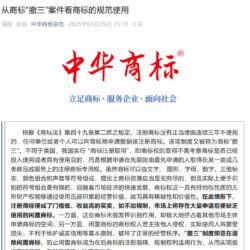The primary concern of each trademark rightholder in a trademark dispute is how to collect evidence quickly and efficiently of trademark popularity, and therefore obtain a more positive trial or adjudication outcome. Making a logical and clear checklist for evidence collection is not only beneficial to the right holders, but also helps them collect more evidence. This is important for forming a chain.
The collection of evidence often poses the following problems.
1. The evidence collected did not emphasize the main points and was randomly listed, without distinguishing the primary and secondary level. This means that the examiner can’t catch the important evidence during the trial.
2. It is important to consider the industry-specific characteristics of the client when preparing the list of proof.
3. The process of collecting evidence is often a collaborative effort between rights holders and multiple departments in the company. Some foreign companies even work across countries and regions. The generalized list of evidence increases the costs associated with internal communication by rights holders
There are many challenges in proving the popularity of trademarks within China.
To prove the popularity and popularity of a trademark, foreign rights holders can provide the following evidence to the examiner.
Previous cases of trademark protection
The previous case of trademark is extremely important. To protect the trademarks of rights holders or to show the popularity of a trademark, records can be made. For instance, they may include judgments, rulings decisions and other legal documents. It is important to note that the most recent case provides the best evidence. In collecting this evidence, you should focus on preserving, classifying, and integrating content from the adjudication files that identify the continual use time, scope, and sales volume of the trademark.
Award and Prizes
Medals and certificates awarded by reputable institutions have a higher value.
Certificates, awards, and certificates from industry authorities, national and foreign. You must provide information such as the name and award of the awarding organization, the date the award was made, and any additional details that you can verify through news reports.
Brand ranking
Rankings on brand awareness and brand value. Issued by industry associations or institutions.
You can find lists of brands, both domestic and international.
BrandZ and Brand Finance should include the name of the organization as well as the method used to select the rankings.
Media Reports
Newspapers and magazines, as well as online media, provide mainstream media news.
1. The search engine (such Google, Baidu, and others) Results pages of the goods associated with the trademark in question.
2. The trademark is evaluated by the media, public platforms and e-commerce platforms. Third-party self-media, such as Xiaohongshu and Zhihu (Weibo), WeChat Public Number, etc.
3. It is possible to collect additional evidence to prove the Chinese public can access the evidence through internet and media, even if the evidence is extraterritorial.
4. A library search can also be a useful tool.
It is important to classify, distill and describe the above evidence with a clear time line.
Advertising
Documentation of promotional and advertising activities in radio, film, TV, newspapers and periodicals, Internet, outdoor, and other media.
You should provide proof of payment of advertising fees, invoices and specific advertising styles (video or photo), an advertising calendar, statistics from media platforms about the advertising amount or advertising ranking for products that are related to your trademark application.
Sales documents
The invoice and sales contract should match, and each seller should submit the purchase invoices in each province for each quarter.
You should list each item in order of importance, including the amount, time and date. To prove that the infringing parties are aware of trademarks, evidence can be presented within a particular timeframe or geographical area.
Evidence of sales in ecommerce, including distribution contracts, invoices for VAT, records of brand sales, analysis statistics, rankings, and other evidence from the ecommerce company.
You can also show proof of import or export. This includes the goods’ import and/or export declaration, entry and exit inspection and quarantine certificate, tariff special payment certificate for imports and/or exports, and any other documents with Chinese customs stamps.
Other kinds evidence
If the right holders’ use of trademarks, sales and promotions of their products in China are not enough to prove the popularity of their brands, they will need to show more evidence.
1. The design concept and creative origin of the mark;
2. The earliest trademark use by the right-holder in China (or elsewhere), which is far earlier than that of the infringing trademark. This suggests that the other trademark is suspected to be copying, imitating or translating the prior trademark use.
3. Evidence of valid registration by the right-holder in China, in its country or in other countries, regions and countries, and evidence of continuous use of a trademark in China;
4. Gather as much information about the brand in China from Chinese media, reviews online from users and overseas purchases.
5. The business license, approval certificate, and proof of capital contributions relationship of the foreign rights holder can prove that the operation has been uninterrupted. Evidence of sales and promotion trademarks must be combined in order to prove this.
6. In the case of a trademark right holder licensing to a third-party company in China the legal relationship of the trademark registrant and trademark user must be established. This can be done by proving the trademark authorization letter, license filing notices, trademark user qualifications, incoming mail and so on.


